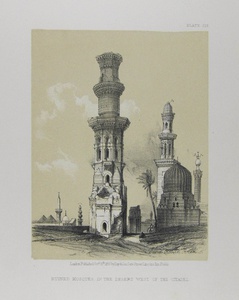| Method | Lithograph with tint stone |
| Artist | after David Roberts |
| Published | London, Published Octr. 15th. 1856 by Day & Son, Gate Street, Lincoln's Inn Fields |
| Dimensions | Image 158 x 120 mm, Sheet 288 x 200 mm |
| Notes |
Plate 219 from Volume 6 of the small format reprint of Roberts' The Holy Land, Syria, Idumea, Arabia, Egypt & Nubia. A view of the minarets of a number of ruined mosques outside the city walls of Cairo, Egypt. Many of the mosques, both inside of Cairo and without, had fallen out of use or become ruined in the centuries before Roberts' journey. Most recently, the cause for this had been the dwindling of Mamluk power and the disastrous effects of Napoleon's Battle of the Pyramids and the subsequent reduction of the region after the Revolt of Cairo. In Roberts' view a number of minarets now stand alone in the desert, their mosques reduced to ruins. In the distance, the city walls and the towers of other mosques can be seen, as well as the outlines of the Pyramids. David Roberts RA (24th October 1796 – 25th November 1864) was a Scottish painter. He is especially known for a prolific series of detailed prints of Egypt and the Near East produced during the 1840s from sketches made during long tours of the region (1838-1840). This work, and his large oil paintings of similar subjects, made him a prominent Orientalist painter. He was elected as a Royal Academician in 1841. The firm of Day & Haghe was one of the most prominent lithographic companies of the nineteenth-century. They were also amongst the foremost pioneers in the evolution of chromolithography. The firm was established in 1823 by William Day, but did not trade under the moniker of Day & Haghe until the arrival of Louis Haghe in 1831. In 1838, Day & Haghe were appointed as Lithographers to the Queen. However, and perhaps owing to the fact that there was never a formal partnership between the two, Haghe left the firm in the 1850's to devote himself to watercolour painting. The firm continued as Day & Son under the guidance of William Day the younger (1823 - 1906) but, as a result of a scandal involving Lajos Kossuth, was forced into liquidation in 1867. Vincent Brookes bought the company in the same year, and would produce the caricatures for Gibson Bowles' Vanity Fair magazine, as well as the illustrations for Cassells's Poultry Book, amongst other commissions. Condition: Slight foxing to margins, not affecting image. |
| Framing | unmounted |
| Price | £30.00 |
| Stock ID | 39045 |

